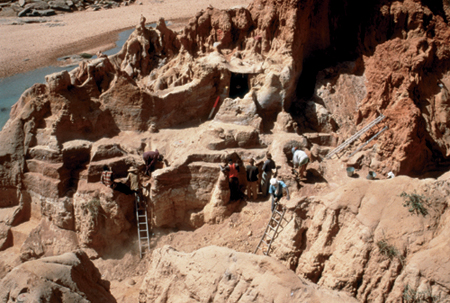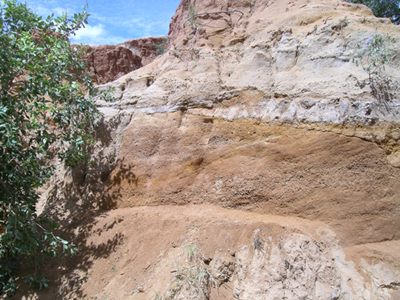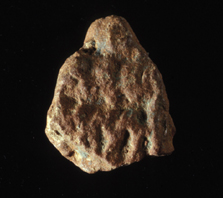Introduction

Excavations in the Early Holocene levels (HR4) at the Ravin du Hibou site, winter 1997-1998. Photo A. Mayor
The Ogolian, an extremely arid episode beginning in West Africa around 23,000 BP, is represented at Ounjougou by a significant sedimentary and archaeological hiatus. It is not until the return of humid climatic conditions at the beginning of the Holocene that we once again find evidence for humans in this part of the continent. It is thus in a context of heavy rains and recolonization of the vegetal cover, at the beginning of the 10th mill. BC, that a new population established on the Bandiagara Plateau. At the Ounjougou site complex, several sites have made it possible to define two occupation phases chronologically situated between 10,000 and 7,000 cal BC. Strikingly, the presence of pottery is attested from the first half of the 10th mill. BC. This is the earliest evidence for pottery in sub-Saharan Africa. The use of stone milling material is confirmed from the 8th mill. BC by the discovery of a millstone and a grinder.
Issues and objectives
It is thus within a context of climatic and environmental change, of migrations and repopulation of a region of Africa abandoned for several thousand years that the craft of making pottery and the use of milling emerged. Our aims are to better understand the material culture of these Early Holocene populations, to determine their origins and identify their development, and finally to clarify the palaeoenvironmental context in which they were established and evolved. Understanding of the mechanisms in which humans invented pottery and milling tools clearly lie at the heart of our research problem. Our main objective is therefore to excavate stratified sites located in the valley base, geologically in situ, to obtain the broadest sample possible of material remains, to situate the site in relative and absolute chronologies and to place them in relation to the geomorphological and archaeobotanical sequence. By comparison to the rare contemporaneous assemblages in West and Saharan Africa, we hope to retrace the route of humans after the vegetation had returned at the beginning of the Holocene. Finally, via systematic survey, we hope to discover contemporaneous site yielding complementary data on these populations, in terms of subsistence economy or the use of space.
The 10th and 9th millennia BC (Phase 1 of the Holocene of Ounjougou)
It is at the site of Ravin de la Mouche that we identify the first Holocene sedimentary sequence, in the form of a channel cut into the yellow Pleistocene silts, infilled with coarse sand and gravel. The chronological placement of the upper layers of this first group has been determined by 12 radiocarbon dates and 3 OSL dates between 9,400 and 8,400 cal BC. The lithic industry discovered in stratigraphic position shows that unidirectional reduction predominates, but other techniques, such as bipolar reduction on anvil and multidirectional, were also employed. Quartz was the main raw material used and the typological range includes small retouched flakes, borers and especially an original type of bifacial armatures with covering retouch.
Three ceramic sherds are linked to this industry. They all come from the base of the HA1A stratigraphic unit. Their thickness ranges between 4.5 and 7 mm. The only recognizable form is an hemispherical bowl of 21 cm diameter with a simple rim. One sherd shows a roulette decoration, which could not be further identified. Microscopic analysis of two samples revealed that they contain a silicate matrix, without carbonates, with 20-30% of non-plastic inclusions. These consist mainly of single crystal quartz well rounded with an edge of recrystallization, with a fine to very fine diameter. These quartz are quite similar to those found in local sandstone and clays. Mineralogical analysis of the nearest clay deposits by X-ray diffraction revealed the presence of kaolinite, whose absence in ceramics indicates a cooking temperature above 550 °C. The pastes were prepared using non-calcareous clays with little prior treatment, as shown by their texture somewhat chaotic. The serial structure indicates that no temper has been intentionally added. Only one sherd contains fragments of grog, with a maximum diameter of 4 mm. However, this low percentage may indicate involuntary incorporation during the preparation of the paste.
The 8th millennium BC (Phase 2 of the Holocene of Ounjougou)
The next part of the Holocene sequence is documented at two mainl sites – the Ravin du Hibou and Damatoumou. The archaeological layers are chronologically situated by an OSL date and 7 radiocarbon dates (8,000-7,000 cal BC). The lithic industry is characterized by reduction of quartz cobbles by unidirectional, bidirectional, multidirectional, peripheral and bipolar on anvil reduction techniques. The assemblage is composed mainly of microlithic tools: borers, backed points, notches, denticulates, sidescrapers, retouched flakes and geometric microliths.
At Ravin du Hibou, seven ceramic sherds were recovered during excavation; highly fragmented, they cannot be used to reconstruct recipient forms. Quartz is present as temper in all of the sherds. A single sherd also contains grog. Decorative elements present on two sherds reflect several distinct techniques, including simple comb impression. Grinding material in stratigraphic position includes a sandstone millstone fragment and a cylindrical knob.
West African and Saharan contexts
The ceramics and grinding material from phases 1 and 2 at Ounjougou are the earliest evidence of this type currently known in sub-Saharan Africa. In our present state of knowledge, the pottery at Ounjougou may have resulted from a center of invention in the current Sahelo-Sudanian zone with exportation somewhat later toward the Central Sahara, where it is known from the 9th mill. BC. The pottery types at Tagalagal in Niger, the earliest known for this region, were already quite diversified when they first appeared, perhaps confirming the adoption of the use of pottery from another place of origin. The lithic industry of phases 1 and 2 is characterized by southern affinities, including quartz microliths using bipolar reduction on anvil proper to the “sub-Saharan microlithic technocomplex” defined by K. MacDonald, except for the bifacial armatures which are only found in the north, in the Saharan zone, at slightly younger sites. A cultural influx from the southeastern sub-Saharan zone toward the Sahara could explain the spread of quartz microlithic industries across West Africa. First observed in Cameroon at Shum Laka (30,600-29,000 BC), we next find them in Ivory Coast at Bingerville (14,100-13,400 BC), in Nigeria at Iwo Eleru (11,460-11,050 BC) and finally at Ounjougou (phase 1: 10th mill. BC).


